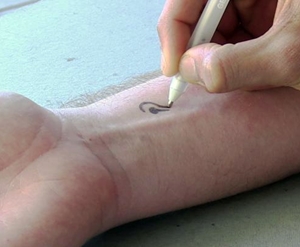3 March 2015. Researchers at University of California in San Diego developed a way to create bioactive inks to use in hand-drawn sensors when needed at the point of care and other applications in the field. The team from the lab of nanoengineering professor Joseph Wang reported on their proof-of-concept findings last week in the journal Advanced Healthcare Materials (paid subscription required).
The San Diego team was seeking simple techniques to create sensors for tests involving biological processes, such as detection of pathogens or biological agents, health screening, and environmental monitoring. The solution needed to be safe for animals (including humans) and plants, adhere to surfaces, conduct an electric current, and easy to store and apply when needed.
Wang and colleagues tested a number of compounds and materials with the capability to meet these conditions. One of the key ingredients in their solution is polyethylene glycol, a biocompatible polymer found in cosmetics and skin creams as a binder and emulsifier, as well as over-the-counter medications, such as laxatives. For electrical conductivity, the researchers added graphite powder.
For the ink to stick to surfaces after being applied, researchers added chitosan, a natural sugar found in the hard outer skeleton of shellfish and used in wound dressings to stop bleeding. They also included xylitol, a naturally occurring alcohol used as a sugar substitute, but in this case to stabilize the active enzymes for testing added to the inks.
The team then loaded the inks into standard off-the-shelf ballpoint pens to be dispensed and applied. The first demonstration was to test for blood sugar or glucose levels, with a test enzyme added to the ink. Participants in the test drew a specified test pattern on a flexible plastic strip fitted with an electrode. The subjects next drew a drop of blood from a fingertip and spread the blood on the strip, which recorded their glucose levels, and transmitted the readings to a measuring device. The subjects then cleaned the strip and repeated the test after a meal, showing changes in glucose levels.
In a similar test, the researchers showed test patterns could be drawn directly on the skin rather than using a plastic strip. The readers were then transmitted over a Bluetooth link to a potentiostat, a device for measuring biochemical reactions.
A different test showed the inks could be applied to test for the presence of pollutants or hazardous materials. The researchers added enzymes to test for the compound phenol, also known as carbolic acid, an industrial chemical found in cosmetics and sunscreen, but also considered toxic by regulatory authorities in the U.S. and overseas. The team drew test patterns with the phenol test ink on leaves, then dipped the leaves in a water mixed with phenol, with readings on a connected pollution detector showing the presence of phenol in the water.
Wang and colleagues next plan to develop more wireless links to the hand-drawn sensors, and test the process further in more demanding conditions, such as extreme temperatures and longer exposure to sunlight.
Read more:
- Paper-Based Synthetic Bio Sensors, Circuits Developed
- Graphene Sensor Designed for Wearable Disease Detection
- Challenge Seeks Development Partner for Nanotech Biosensor
- Mobile App/Sensor Designed to Help Parents Control Stress
- Simple, Sensitive Biosensors Derived from Engineered Viruses
* * *


 RSS - Posts
RSS - Posts
You must be logged in to post a comment.